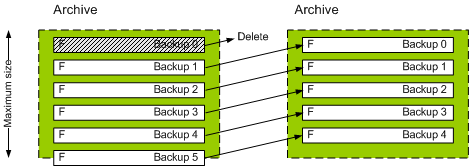
The backups produced by a backup plan make an archive. The two retention rules described in this section enable you to limit the archive size and set the lifetime (retention period) of the backups.
The retention rules are effective if the archive contains more than one backup. This means that the last backup in the archive will be kept, even if a retention rule violation is detected. Please do not try to delete the only backup you have by applying the retention rules before backup. This will not work. Use the alternative setting Clean up archive > When there is insufficient space while backing up if you accept the risk of losing the last backup.
1. Delete backups older than
This is a time interval counted back from the moment when the retention rules are applied. Every time a retention rule is applied, the program calculates the date and time in the past corresponding to this interval and deletes all backups created before that moment. None of the backups created after this moment will be deleted.

2. Keep the archive size within
This is the maximum size of the archive. Every time a retention rule is applied, the program compares the actual archive size with the value you set and deletes the oldest backups to keep the archive size within this value. The diagram below shows the archive content before and after the deletion.

There is a certain risk that all but one backup will be deleted if the maximum archive size is set improperly (too small) or a regular backup turns out to be too large. To protect the recent backups from deletion, select the Never delete backups younger than check box and specify the maximum age of backups that must be retained. The diagram below illustrates the resulting rule.

Combination of rules 1 and 2
You can limit both the backups’ lifetime and the archive size. The diagram below illustrates the resulting rule.

Example
Delete backups older than = 3 Months
Keep the archive size within = 200GB
Never delete backups younger than = 10 Days
Deleting backups with dependencies
Both retention rules presume deleting some backups while retaining the others. What if the archive contains incremental and differential backups that depend on each other and on the full backups they are based on? You cannot, say, delete an outdated full backup and keep its incremental “children”.
When deletion of a backup affects other backups, one of the following rules is applied:
The outdated backup will be kept until all backups that depend on it also become outdated. Then all the chain will be deleted at once during the regular cleanup. This mode helps to avoid the potentially time-consuming consolidation but requires extra space for storing backups whose deletion is postponed. The archive size and/or the backup age can exceed the values you specify.
The program will consolidate the backup that is subject to deletion with the next dependent backup. For example, the retention rules require to delete a full backup but retain the next incremental one. The backups will be combined into a single full backup which will be dated the incremental backup date. When an incremental or differential backup from the middle of the chain is deleted, the resulting backup type will be incremental.
This mode ensures that after each cleanup the archive size and the backups’ age are within the bounds you specify. The consolidation, however, may take a lot of time and system resources. And you still need some extra space in the vault for temporary files created during consolidation.
What you need to know about consolidation
Please be aware that consolidation is just a method of deletion but not an alternative to deletion. The resulting backup will not contain data that was present in the deleted backup and was absent from the retained incremental or differential backup.
Backups resulting from consolidation always have maximum compression. This means that all backups in an archive may acquire the maximum compression as a result of repeated cleanup with consolidation.
Best practices
Maintain the balance between the storage device capacity, the restrictive parameters you set and the cleanup frequency. The retention rules logic assumes that the storage device capacity is much more than the average backup size and the maximum archive size does not come close to the physical storage capacity, but leaves a reasonable reserve. Due to this, exceeding the archive size that may occur between the cleanup task runs will not be critical for the business process. The rarer the cleanup runs, the more space you need to store backups that outlive their lifetime.
The Vaults page provides you with information about free space available in each vault. Check this page from time to time. If the free space (which in fact is the storage device free space) approaches zero, you might need to toughen the restrictions for some or all archives residing in this vault.